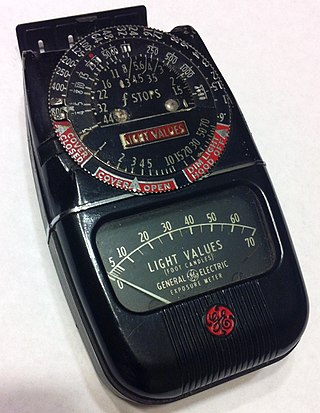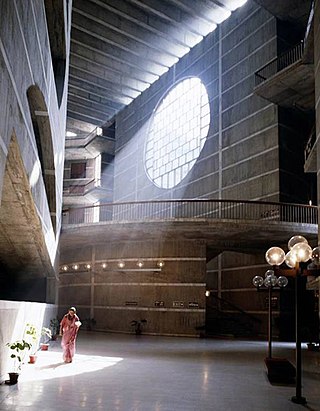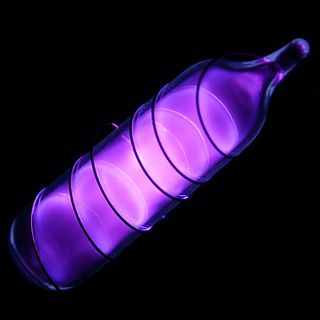Related Research Articles

Daylighting is the practice of placing windows, skylights, other openings, and reflective surfaces so that direct or indirect sunlight can provide effective internal lighting. Particular attention is given to daylighting while designing a building when the aim is to maximize visual comfort or to reduce energy use. Energy savings can be achieved from the reduced use of artificial (electric) lighting or from passive solar heating. Artificial lighting energy use can be reduced by simply installing fewer electric lights where daylight is present or by automatically dimming or switching off electric lights in response to the presence of daylight – a process known as daylight harvesting.

The lux is the unit of illuminance, or luminous flux per unit area, in the International System of Units (SI). It is equal to one lumen per square metre. In photometry, this is used as a measure of the intensity, as perceived by the human eye, of light that hits or passes through a surface. It is analogous to the radiometric unit watt per square metre, but with the power at each wavelength weighted according to the luminosity function, a model of human visual brightness perception, standardized by the CIE and ISO. In English, "lux" is used as both the singular and plural form. The word is derived from the Latin word for "light", lux.

Lighting or illumination is the deliberate use of light to achieve practical or aesthetic effects. Lighting includes the use of both artificial light sources like lamps and light fixtures, as well as natural illumination by capturing daylight. Daylighting is sometimes used as the main source of light during daytime in buildings. This can save energy in place of using artificial lighting, which represents a major component of energy consumption in buildings. Proper lighting can enhance task performance, improve the appearance of an area, or have positive psychological effects on occupants.

Photometry is a branch of science that deals with the measurement of light in terms of its perceived brightness to the human eye. It is concerned with quantifying the amount of light that is emitted, transmitted, or received by an object or a system.

A foot-candle is a non-SI unit of illuminance or light intensity. The foot-candle is defined as one lumen per square foot. This unit is commonly used in lighting layouts in parts of the world where United States customary units are used, mainly the United States. Nearly all of the world uses the corresponding SI derived unit lux, defined as one lumen per square meter.

A compact fluorescent lamp (CFL), also called compact fluorescent light, energy-saving light and compact fluorescent tube, is a fluorescent lamp designed to replace an incandescent light bulb; some types fit into light fixtures designed for incandescent bulbs. The lamps use a tube that is curved or folded to fit into the space of an incandescent bulb, and a compact electronic ballast in the base of the lamp.

An emergency light is a battery-backed lighting device that switches on automatically when a building experiences a power outage.

Architectural lighting design is a field of work or study that is concerned with the design of lighting systems within the built environment, both interior and exterior. It can include manipulation and design of both daylight and electric light or both, to serve human needs.

An electrical ballast is a device placed in series with a load to limit the amount of current in an electrical circuit.

A light fixture, light fitting, or luminaire is an electrical lighting device containing one or more light sources, such as lamps, and all the accessory components required for its operation to provide illumination to the environment. All light fixtures have a fixture body and one or more lamps. The lamps may be in sockets for easy replacement—or, in the case of some LED fixtures, hard-wired in place.

Energy conversion efficiency (η) is the ratio between the useful output of an energy conversion machine and the input, in energy terms. The input, as well as the useful output may be chemical, electric power, mechanical work, light (radiation), or heat. The resulting value, η (eta), ranges between 0 and 1.

A grow light is an electric light to help plants grow. Grow lights either attempt to provide a light spectrum similar to that of the sun, or to provide a spectrum that is more tailored to the needs of the plants being cultivated. Outdoor conditions are mimicked with varying colour temperatures and spectral outputs from the grow light, as well as varying the intensity of the lamps. Depending on the type of plant being cultivated, the stage of cultivation, and the photoperiod required by the plants, specific ranges of spectrum, luminous efficacy and color temperature are desirable for use with specific plants and time periods.

An LED lamp or LED light is an electric light that produces light using light-emitting diodes (LEDs). LED lamps are significantly more energy-efficient than equivalent incandescent lamps and fluorescent lamps. The most efficient commercially available LED lamps have efficiencies exceeding 200 lumens per watt (lm/W) and convert more than half the input power into light. Commercial LED lamps have a lifespan several times longer than both incandescent and fluorescent lamps.
Often task lighting refers to increasing illuminance to better accomplish a specific activity. However, the illuminance level is not the only factor governing visibility. Contrast is also important, and a poorly positioned light source may cause contrast reduction, resulting in loss of visibility. The most important purpose of task lighting in the office is not increasing illuminance, but improving contrast. General lighting can be reduced because task lighting provides focused light where needed.

A surgical light – also referred to as an operating light or surgical lighthead – is a medical device intended to assist medical personnel during a surgical procedure by illuminating a local area or cavity of the patient. A combination of several surgical lights is often referred to as a “surgical light system”.

Plasma lamps are a type of electrodeless gas-discharge lamp energized by radio frequency (RF) power. They are distinct from the novelty plasma lamps that were popular in the 1980s.

In architecture, a daylight factor (DF) is the ratio of the light level inside a structure to the light level outside the structure. It is defined as:
Lumen maintenance is the most useful gauge to determine the lifetime or useful light output rating of an LED light source. Unlike traditional light sources such as incandescent lamps, LEDs rarely fail outright and instead continue to emit light, albeit at slowly diminishing rate over time. Lumen maintenance is the luminous flux remaining at any selected elapsed operating time. Lumen depreciation is the luminous flux lost over time, and thus the complement of lumen maintenance.

LED tube is a type of LED lamp used in fluorescent tube luminaires with G5 and G13 bases to replace traditional fluorescent tubes. As compared to fluorescent tubes, the most important advantages of LED tubes are energy efficiency and long service life. LED tubes are sometimes also referred to as ‘LED fluorescent tubes’.
Climate based daylight modelling (CBDM) also known as dynamic daylight metrics is a calculation methodology first developed in the late 1990s to assess daylight quality and quantity. It is used by Building Design engineers and architects to predict luminance and/or illuminance within buildings using standardised sun and sky condition climate data for a given geographical location. It is a different design metric to Daylight factors which only considers the ratio of the light level inside a structure to the light level outside the structure from an overcast sky. With CBDM, if used considerately, the facade design of a building can be optimised to maximise useful daylight whilst excluding excessive daylight, which otherwise might cause issues with glare, visual discomfort, and/or solar gains which can cause thermal comfort issues. At the same time reducing reliance and operation of artificial lighting. CBDM calculations are calculated within Building simulation modelling software tools for each and every hour of the year, or sometimes for smaller increments, which allows for daily and seasonal profiles to be tested and optimised
References
- ↑ "Light Calc". Glossary. Archived from the original on 2008-03-16. Retrieved 2008-03-20.
- ↑ Steffy, LC, IES, FIALD, Gary 1963. Architectural Lighting Design, 2nd edition John Wiley & Sons, Inc., New York
- ↑ Rea, PH. D., FIES, Mark S., Illuminating Engineering Society of North America (2000), "The IESNA Lighting Handbook", 9th edition, 8-11 to 8-14
- ↑ "What Are Different Lighting Distribution Types?". 2024-02-02. Retrieved 2024-04-21.
- ↑ Hughes, S. David (1988), "Electrical Systems in Buildings", 150, Delmar Publishers Inc